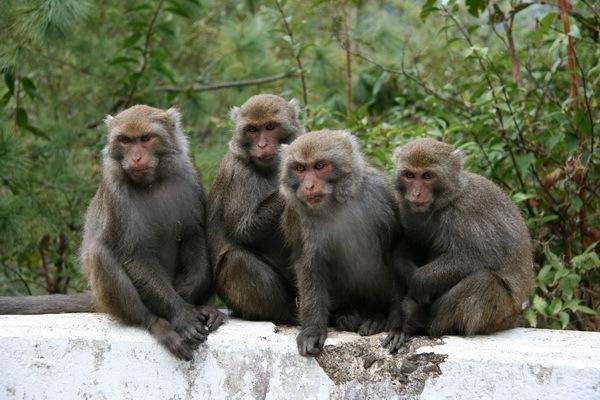Macaca cyclopis
IUCN
LCBasic Information
Scientific classification
- name:Macaca cyclopis
- Scientific Name:Macaca cyclopis Swinhoe,Formosan macaque, black-limbed monkey, rock-dwelling macaque
- Outline:Primates
- Family:Primates Cercopithecidae Macaca
Vital signs
- length:36-54cm
- Weight:4-5kg
- lifetime:20year
Feature
The fur on the limbs is dark, and the hands and feet are black, so it is also called "black-limbed monkey".
Distribution and Habitat
Taiwan macaques are only found in Taiwan, China. They are most abundant in the dense forests of Shoushan Mountain in Kaohsiung, so they are called Taiwan macaques. They were first discovered in the rocky areas of the southern coast, so they are also called "rock-dwelling macaques". Later, they were also found in the dense forests of high mountains above 3,000 meters in the central inland. As of 2005, the known distribution locations in Taiwan, China are: Guangfu, Changhua, Yuli, Yannian, Wulai, Taishun, Taipingshan, Taichung, Taitung, Sanxia, Shanping, Mingtan, Pingtung, Nantou, Muzha, Tainan, Kenting, Yilan, Hengchun, Guanshan, Chiayi, Kaohsiung, Qingshuigou, Xitou, Baguashan, Anmashan, Hualien, Taroko, etc.
They live in rock walls and forests, feed on various wild fruits, leaves, insects, frogs, and sometimes steal farmers' grains and fruits.
Appearance
The fur color of the body is mainly blue-gray slate or gray-brown, without any bright colors such as orange. The bare hair on the forehead is gray-yellow, the head is round and thick, and the crown is somewhat reddish-brown. The typical pink face, the face is relatively flat, flesh-colored or slightly darker than flesh-colored, but not red or white like other monkeys. The cheeks are covered with dense whiskers, and the cheek pouches are smaller than those of macaques, and the top hair is scattered backwards. The fur on the limbs is dark, and the hands and feet are black, so it is also called "black-limbed monkey". The structure of the male's genitals is of the same type as macaques, Japanese monkeys, crab-eating macaques, etc. During the ovulation period, the female's buttocks, thighs, tail roots and other parts have obvious redness and swelling. The tail is very thick, with dense tail hair, olive color at the base and gray at the end, obvious black stripes in the m
Details
The Formosan monkey is endemic to China.

The Formosan monkey is similar to the macaque, but with a grayer body and darker tail. Their tails are both more than half the length of their bodies, but the Formosan monkey's tail is proportionally longer, smaller and fatter than the macaque's.
Around 1950, Formosan macaques could still be seen in zoos in mainland China, but in the 21st century, Formosan macaques have become extinct in mainland China and only exist in Taiwan. In November 1977, locals in the Central Mountain Range of Hualien County, Taiwan, captured a female Formosan macaque with a white body and named it "Meidi". After the incident was reported by the US Daily News and the BBC, the then French President, German President and Queen of England paid close attention to it. Some of them even wrote to the media, hoping to see photos of the white Formosan macaque with their own eyes. The fact that politicians pay attention to Formosan macaques also shows how rare this species is.
In 1980, a male Formosan macaque with a white body was also found in Yongsheng, Yunnan, and named "Nannan". Pan Qinghua, director of the Kunming Institute of Zoology of the Chinese Academy of Sciences at that time, wrote to Wang Yaping, director of the Taipei Zoo, and Xu Fangjin, deputy director, respectively, expressing his hope that the rare white macaques on both sides of the Taiwan Strait would marry and reproduce pure offspring. This matter was reported by major domestic media that year and attracted national attention, but due to various reasons, this good wish was ultimately not realized.
In 1984, Taiwan Province proposed a protection strategy and established "Ershui", "Taitung", "Kenting" and other nature reserves mainly for the protection of Taiwan monkeys, effectively protecting this unique species. With the obvious increase in the number of Taiwan monkeys, in August 1997, a group of 200-300 Taiwan monkeys was found in the Tatajia saddle of the new Central Cross-Island Highway in Taiwan Province, China. In addition, a small number of Taiwan monkeys have been introduced to some islands in Japan.
The native population is only distributed on Taiwan Island, my country, with about 250,000 individuals. In addition, a small number of introduced populations are found in Japan. The natural enemy of the Taiwan monkey is mainly the clouded leopard, but the clouded leopard has long been extinct in Taiwan. After years of protection, the population of the Taiwan monkey has shown a steady upward trend.
China Species Red Book: China RL — EN
CITES: Not listed
IUCN Red List of Threatened Species: IUCN RL —LC ver3.1 2008
Listed in the first level of the "List of National Key Protected Wildlife in China".
Protect wildlife and eliminate game.
Maintaining ecological balance is everyone's responsibility!








